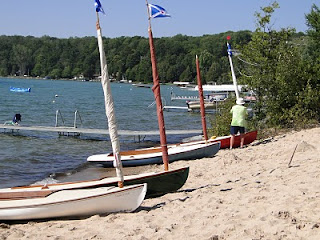Now that the Honcho is up for sale, were beginning to look for another boat and another adventure. Ive always liked J Boats, so I couldnt wait to see the new J/111, which we thought might be a fun high performance cruiser that would suit our needs. Well, after checking one out, we decided to keep looking because its not quite big enough for the voyages we are contemplating. But that doesnt mean its not a great boat. In fact, I think its one of the better boats J Boats has produced.
 |
| J/111 Outboard Profile |
The J/111 is, in my opinion, a continuation of the J/35 theme...A fast, seaworthy boat that is offshore capable, but is most comfortable as a racer that a couple could easily spend a week at the island aboard. This is a type that J Boats excels at, so I though it would be fun to do a review of this design. A few years ago I spent some time cruising aboard a similar boat, an Aerodyne 38 called "Matador" and really enjoyed sailing across the southern reach of the Sea of Cortez from Cabo to Mazatlan aboard her. In 2003 we won our class in the Newport - Ensenada race in the same boat. Ill add some photos of both boats for your viewing pleasure, and Ill take this opportunity to credit Yachtworld.com for all of photos of both boats. I also encourage you to visit www.rodgermartindesign.com if youre interested in learning more about the A/38.
 |
J/111
|
The J/111 reflects the state of the art in boats of this genre. With its plumb bow, long waterline, near vertical transom and bulb keel, the hull looks fast and its PHRF base rating of 42 looks about right to me. Interestingly, the Aerodyne 38 rates the same.
 |
| Aerodyne 38 |
Both boats have a deep bulb keel with a vertical leading edge and the all-important kelp cutter. This keel shape is one I have used in my own designs and it really is more efficient than, say, the keel on the Honcho.
 |
J/111 Keel
The Aerodynes keel has a more torpedo-shaped bulb than this. |
Both the J/111 and Aerodyne 38 have deep carbon fiber rudders and wheel steering. The wide sterns of these boats demand deep rudders to keep them from stalling when the boat is heeled at speed. Rudders on boats of this type are usually large relative to the keel as they not only steer the boat but help generate lift to weather as well.
I really like the aesthetics of both boats. The 111 looks more modern but that is to be expected. The cockpits are large and incorporate seating forward and wide open space aft. This is efficient for racing, but makes for a surprisingly friendly place to be if youre cruising, provided that the seats are long enough for an occasional snooze.
 |
| J/111 accommodations |
Going below, the basic layout of the J/111 looks lightweight and efficient for racing. For cruising it would be snug. Notice that the head and V-berth are in the same cabin space. Id remove the cushions and relegate the V-berth to storage only. The quarterberths might be big enough for two and the settees in the main cabin would make reasonably good sea-berths if they were fitted with lee cloths. The galley is small, but probably adequate for short cruises and fixing simple meals for a racing crew. I like the nav station. Its big and has plenty of storage space.
 |
J/111 interior
Light and open spaces abound |
 |
Aerodyne 38 main cabin
Engine is under the sinks |
The Aerodyne, by contrast is oriented more for offshore racing or cruising. The layout incorporates a head aft to port and large quarterberth to starboard. The galley has plenty of counter space, with the Yanmar engine under the double sinks. The forward cabin is spacious and has a berth big enough for two.
The sailplans of both boats are similar. Big main, non-overlapping jibs, asymmetrical spinnakers on retractable poles, carbon fiber mast. Whats not to like here?
 |
Aerodyne 38
High speed cruising |
 |
J/111 Under sail
Sweet! |
I have not yet had an opportunity to sail the J/111 so I can only speculate on how the boat handles, but it is similar enough to some of my own designs and to the Aerodyne 38, which I have sailed, to expect that it will be very quick, with a light helm and fast acceleration out of tacks. The deep, high aspect ratio keel and fine bow combined with the lightweight and efficient sailplan will make it fast upwind. The high sail area/displacement ratio means it will be quick to heel in puffs and will require close attention to sail trim in windy conditions, but it will reward you with high speeds downwind. Overall, an exciting boat to sail. I can say the same for the Aerodyne, athough it will be a slightly more comfortable ride. My guess is that the J/111 will be slightly quicker in light air buoy racing and downwind racing. The Aerodyne would likely be a better choice for the longer downwind races like the Transpac.





































.jpg)




